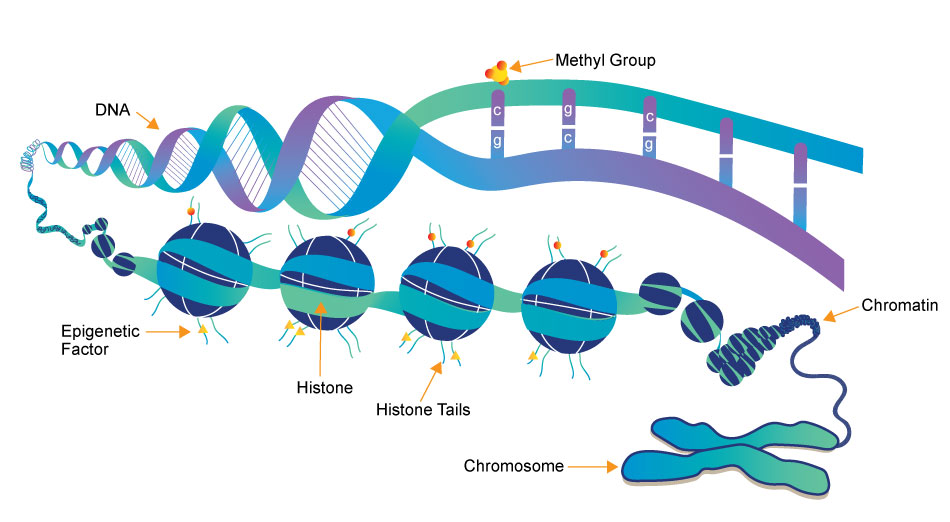Epigenetics


Epigenetics research delves into the molecular mechanisms that control gene expression and cellular traits without altering the underlying DNA sequence. One crucial aspect of this field is the role of small molecules, which act as powerful regulators of epigenetic modifications. These small compounds, typically comprising a few dozen to a few hundred atoms, have emerged as essential tools in understanding and manipulating the epigenome.
- DNA Methylation Inhibitors: Small molecules like 5-azacytidine and 5-aza-2'-deoxycytidine are DNA methyltransferase inhibitors. They block the addition of methyl groups to DNA, leading to DNA demethylation. This can reactivate silenced genes, potentially offering therapeutic avenues for conditions like cancer.
- HDAC inhibitors: HDACs remove acetyl groups from histone proteins, contributing to gene repression. Small molecule HDAC inhibitors, such as Vorinostat and Romidepsin, can reverse this process by increasing histone acetylation, allowing genes to be more accessible for transcription. These inhibitors are being explored for cancer therapy and other conditions.
- Histone Methyltransferase Inhibitors: Small molecules like GSK126 inhibit specific histone methyltransferases, affecting histone methylation patterns. This can alter gene expression, making them promising candidates for cancer and other diseases with epigenetic dysregulation.
- RNA Modulators: Small molecules can also target non-coding RNAs involved in epigenetic regulation. For instance, small molecules called small interfering RNAs (siRNAs) can be designed to target and degrade specific long non-coding RNAs, influencing gene expression.
- Epigenetic Reader Domain Inhibitors: These small molecules target proteins that recognize and bind to specific epigenetic marks. Examples include inhibitors of bromodomain-containing proteins (BET inhibitors), which can disrupt gene regulation by interfering with protein-DNA interactions.
Small molecules in epigenetics research not only provide insights into the fundamental biology of gene regulation but also hold immense promise for developing novel therapeutics. Their ability to selectively modulate specific epigenetic marks and pathways has led to ongoing clinical trials and drug development efforts for various diseases, including cancer, neurological disorders, and inflammatory conditions. Understanding and harnessing the power of these small molecules is at the forefront of modern epigenetics research, offering new hope for precision medicine and targeted therapies.
3 key components involved in the regulation of epigenetic modifications
Epigenetics Writer
Epigenetics writers are enzymes responsible for adding chemical marks or modifications to DNA or histone proteins. These marks include DNA methylation (addition of methyl groups to DNA) and histone modifications (such as acetylation, methylation, phosphorylation, etc.).
Epigenetics Reader
Function: Epigenetics readers are proteins that can recognize and bind to specific epigenetic marks on DNA or histones. These reader proteins interpret the epigenetic code and facilitate downstream cellular processes, such as gene activation or repression.
Epigenetics Eraser
Function: Epigenetics erasers are enzymes responsible for removing or reversing epigenetic marks on DNA or histones. This process allows for the dynamic regulation of gene expression and the resetting of epigenetic states during various stages of development and in response to environmental changes.
-
SIRT1 Activator
SRT1720 是一种抑制剂,旨在作为小分子激活剂,激活 sirtuin 亚型 SIRT1。- Eleni Pitsillou, .et al. , Comput Biol Chem, 2020, 89: 107408 PMID: 33137690
- Jie Ren, .et al. , Sleep Breath, 2018, Nov 8 PMID: 30411173
- Rowlands BD, .et al. , J Neurochem, 2017, Mar;140(6):903-918 PMID: 27925207
- Adam Khader, .et al. , J Surg Res, 2017, Nov;219:288-295 PMID: 29078895
- Adam Khader, .et al. , Crit Care Med, 2016, Aug; 44(8): e651-e663 PMID: 26963320
- Benjamin D. Rowlands, .et al. , J Neurosci Res., 2015, Jul;93(7):1147-56 PMID: 25677687
- Khader A, .et al. , Transplantation, 2014, 98(2):148-56 PMID: 24918615
-
p53 activator
Tenovin-6 是 tenovin-1 的类似物。Tenovin-6 在体外抑制纯化的人类 SIRT1、SIRT2 和 SIRT3 的蛋白去乙酰化酶活性,其 IC50 值分别为 21、10 和 67 微摩尔。- Igase M,, .et al. , Exp Cell Res, 2019, Dec 28:111810 PMID: 31891684
-
Pdia3/ERp57 activator, STAT3 抑制剂
Diosgenin glucoside,一种从Tritulus terrestris L. 提取的皂苷化合物,通过调节小胶质细胞 M1 极化提供神经保护。Diosgenin glucoside 通过调节自噬和减轻凋亡来保护脊髓损伤。 -
SIRT1 activator
SRT2104(GSK2245840)是一种选择性的SIRT1激活剂,参与调节能量平衡。目前处于第二阶段临床试验。- Eleni Pitsillou, .et al. , Comput Biol Chem, 2020, 89: 107408 PMID: 33137690
- Liu X, .et al. , Life Sci, 2019, Nov 9:117041 PMID: 31715188
-
SIRT1 Activator
SRT 1720 是一种选择性激活人类 SIRT1 的化合物(EC1.5 = 0.16 μM),相比于最接近的sirtuin同源物,SIRT2 和 SIRT3,其选择性更高(SIRT2: EC1.5 = 37 μM; SIRT3: EC1.5 > 300 μM)。- Lanlan Yin, .et al. , Placenta, 2024, May:150:52-61 PMID: 38593636
-
SIRT1 activator
SRT 1720 Hydrochloride 是一种选择性的 SIRT1 激活剂,其 EC50 为 0.10 μM,对 SIRT2 和 SIRT3 的活性较弱。 -
CARM1 抑制剂
SGC2085 hydrochloride 是一种强效且选择性的共激活因子相关精氨酸甲基转移酶1 (CARM1) 抑制剂,其半抑制浓度(IC50)为50纳摩尔。 -
Pdia3/ERp57 activator, STAT3 抑制剂
Diosgenin palmitate,也被称为Diosgenin hexadecanoate,是Diosgenin的己十六酸酯。Diosgenin是一种植物甾体皂苷元,是通过酸、强碱或酶对皂苷进行水解后的产物,这些皂苷提取自薯蓣类野生山药的块茎,如Kokoro山药。




